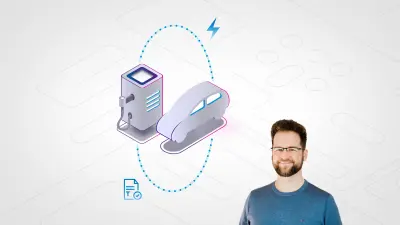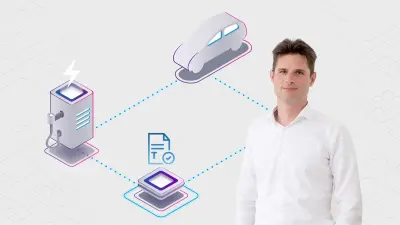Cars that negotiate with charging stations

Wouldn’t it be nice if your car could negotiate the price of electricity when you plug it in to charge it? This is one example of how the "Economy of Things" could potentially improve energy management and other processes in the future.
When Christian Heise and his family make the trip from Stuttgart to Berlin, he gets in the car, enters his destination, and starts driving, just like anyone else would. But what’s going on in the background is anything but ordinary. “This is an insight into the future of the IoT,” Heise explains. As Deputy Director of the “Economy of Things” Project at Bosch, he brings together energy and mobility to create a prototype that will employ blockchain technology to improve the EV charging process, representing a major step forward for the connected world.
Even if all Heise does before setting out is enter his destination, the prototype — a software agent running on a computer in his trunk — knows what’s most important to the driver. Heise has saved the basic parameters for the trip. For one, he never wants the charge to fall below 20 percent on his journey to Berlin. In addition, he’s entered the maximum price he’s prepared to pay for power and would like to grab a coffee with his wife while watching his kid in the playground when the car’s charging.
Being connected delivers economic value

The AI in the EV charging prototype explores ways to achieve the best balance between the following key parameters: reducing the driver’s fear of running down the battery, negotiating the lowest price for charging, and making the time spent waiting as pleasant as possible by listing points of interest in the area. “To be more specific, we bundle the logic in an economic agent, a program code that acts differently in response to varying challenges, which in turn enables the agent to negotiate,” says Heise.
Thus, according to Heise: “Things decide what action makes economic sense from their perspective and that of the person on whose behalf they are acting.” This is the economy of things at its most basic. “Our prototype demonstrates how things can negotiate and exchange real numbers back and forth. Being connected delivers economic value.”
“Things decide what action makes economic sense from their perspective and that of the person on whose behalf they are acting.”
Negotiating the price of resources
The economic agent has to be in a position to communicate with other agents in order to perform its intended mission. To make this possible, Bosch has teamed up with EnBW. The German energy supply company has developed a prototype of a charging point that utilizes an economic agent, too.
This smart charging station manager acts in its own interest to achieve optimal availability, utilization rates, and sales based on the accompanying targets. The car and the charging station are now able to negotiate different and transparent price models and offer them to the driver in real time — depending on the availability of charging stations and electricity generated from renewable sources.
Once the negotiations are complete, a smart contract is drawn up on the blockchain. This standard agreement, which includes the IDs of the vehicle and charging station along with the amount and price of electricity charged, is stored in the decentralized network. “Blockchain serves as the technical basis for coordinating EV charging with any energy provider. We are working with our partners to achieve the necessary legal recognition for contracts like this,” says Heise. Here’s how the process works: The two agents confirm the conditions agreed in the contract, and charging can begin once the EV is plugged in. Heise says, “Our EV charging agent and the charging station's economic agent from EnBW work to deliver the best price based on given targets, while the charging station agent seeks to negotiate optimum prices for resources.”
Negotiating the price of resources
The economic agent has to be in a position to communicate with other agents in order to perform its intended mission. To make this possible, Bosch has teamed up with EnBW. The German energy supply company has developed a prototype of a charging point that utilizes an economig agent, too.
This smart charging station manager acts in its own interest to achieve optimal availability, utilization rates, and sales based on the accompanying targets. The car and the charging station are now able negotiate different and transparent price models that are offered to the driver in real time — depending on the availability of charging stations and electricity generated from renewable sources.
Once the negotiations are complete, a smart contract is drawn up on the blockchain. This standard agreement, which includes the ID of the vehicle and charging station along with the amount and price of electricity charged, is stored in the decentralized network. “Blockchain serves as the technical basis for coordinating EV charging with any energy provider. We are working with our partners to achieve the necessary legal recognition for contracts like this,” says Heise. Here’s how the process works: The two agents confirm the conditions agreed in the contract, and charging can begin once the EV is plugged in. Heise says, “Our EV charging agent and the charging station's economic agent from EnBW work to deliver the best price based on given targets, while the charging station agent seeks to negotiate optimum prices for resources.”

Marketplace for electricity

He believes there is another major advantage to multi-agent decentralized system built on distributed ledger technologies: “Just like any marketplace, the providers supply power along with all the relevant information. This lets the agent scan its environment and find the offer that meets the driver’s needs.” In a centralized system, all devices first have to send their location data and requests to a coordinator, and each electricity provider has to transmit its own data. “All this information has to be generated, is highly complex, and requires massive amounts of computing power,” says Heise. And when he needs to find a charging station quickly at a different location owing to heavy traffic, the search will only encompass areas along Heise’s route, meaning much less coordination and hence fewer resources used.
Socially fair system
As a result, the technology can also provide an answer to the question of whether there is enough electricity for the widespread use of electric vehicles. “Distributed agent-based systems reduce the demands on critical energy infrastructure,” says Heise. AI likewise uses blockchain to help in coordinating charging times and points for cars. “An allocation algorithm might suggest recharging the car at work or leaving it at home and using a ridesharing service to get to work. The next day, the opposite could be the case.” This should contribute towards reducing peak loads.
Heise’s goal is to consolidate the requirements in terms of mobility and energy “by allowing ridesharing services, multimodal transportation models, and energy management to negotiate financial terms with each other.” This is all designed to promote a socially fair system. To this end, Heise and his team are developing an algorithm-based mechanism to prevent key stakeholders from joins forces to raise prices arbitrarily as well as ensure nobody is put at a disadvantage.
How do DLT work?

Loading the video requires your consent. If you agree by clicking on the Play icon, the video will load and data will be transmitted to Google as well as information will be accessed and stored by Google on your device. Google may be able to link these data or information with existing data.
The video explains the technology behind Distributed Ledger technologies such as Blockchain and the steps towards an Economy of Things.
Profile

Christian Heise
Deputy Project Director, “Economy of Things”, Bosch
My goal is to use resources efficiently and still build a socially fair system. The price of electricity must not rise sharply when there is a shortage.
Heise received his bachelor's degree in applied computer science in 2009 and was hired by IBM as a software developer and then promoted to IT architect. During his career at IBM, he received his MSc in software engineering in 2014 while studying part-time. Following IBM, and after three years at BCG Platinion, he joined Bosch in 2017 focusing in Smart City business topics. Starting in 2018, he has transitioned into overseeing energy and mobility topics in his role as Deputy Director of the Economy of Things Project.

